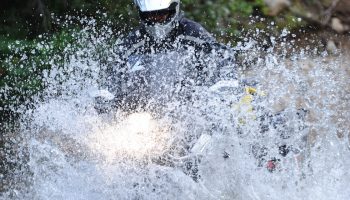Sick of missing out on adventure riding during the winter? Check out these mindset/bike tips and riding techniques that will keep you safe and smiling.
By Ron Lieback
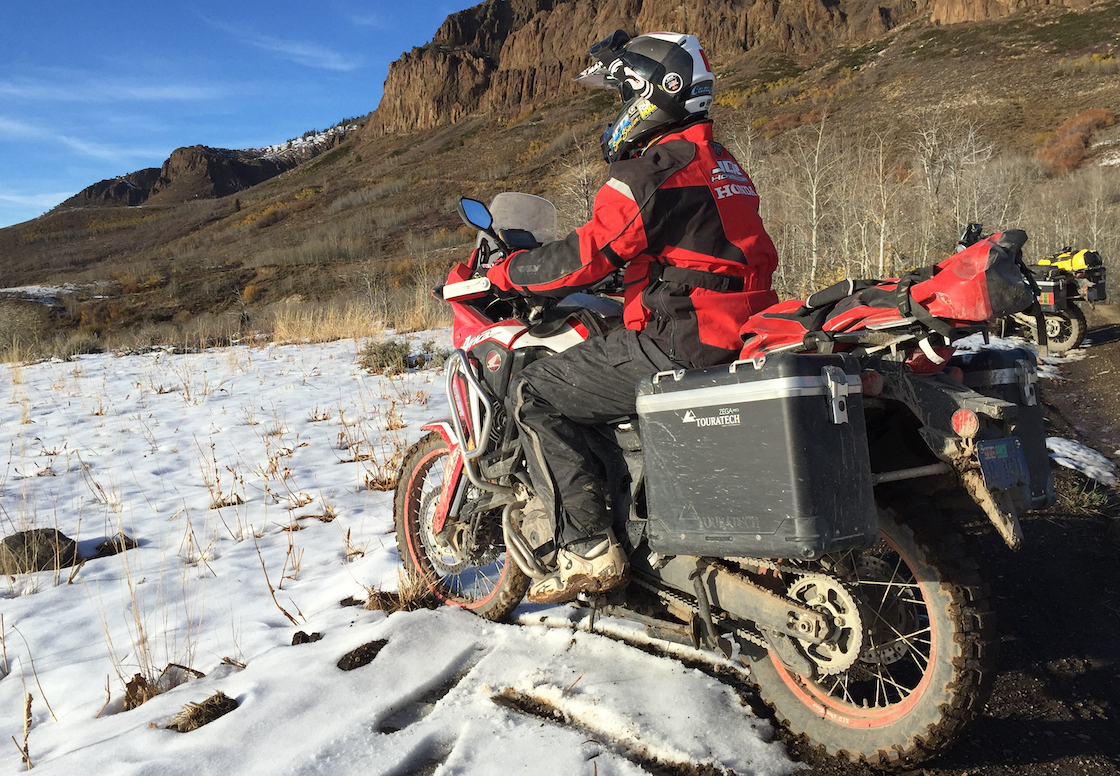
For some, the fear of winter riding equates to taking a big-ole BMW GS or any large displacement motorcycle off-road for the first time.
The thought of riding in cold conditions with minimal traction produces mass amounts of anxiety among many motorcyclists across the globe. Thoughts of numb fingers, a frigid core, some snow falling, or salt ruining motorcycles are just a few of the usual thoughts that twist the nerves.
But with the proper mindset, bike prep, and riding techniques, these negative thoughts are suppressible, which helps resolve the fear factor.
The following tips cover both mental and physical approaches to winter ADV riding, things I’ve learned after riding 12 months a year for the past two decades in the Northeast and accomplishing a few years of over 20,000 miles annually.
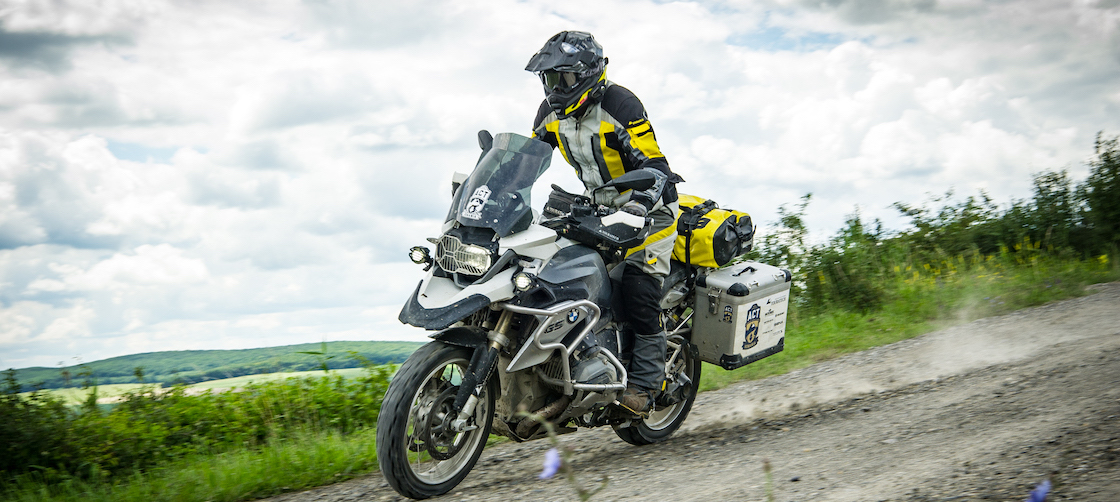
Prep Your Adventure Motorcycle For Winter Riding
Prepping your motorcycle is an absolute must if you want to ride during winter, which equates to riding in cold—sometimes frigid—temperatures and rain or snow. There’s no mentioning of sleeting here because you should never ride in sleet. I got stuck in it numerous times and kissed the pavement multiple times.
Here are the must-haves of a properly prepped motorcycle for winter riding, including the must-have ADV accessories:
- Good Tires: The rubber is going to meet the road in much colder and wetter conditions where traction is extremely minimized. Make sure your tires are in top shape, especially the grooves that can channel the wet stuff quickly. From experience, tires with a mix of deep and short grooves channel water quicker, providing more traction when it’s absolutely needed. And remember—it takes much longer for tires to heat up and provide optimal traction when it’s colder.
- Larger Windscreen: The bigger, the better. The more you can protect yourself from cold winds and perception, the more comfortable you’ll be and the longer you’ll ride. Read more about the wind chill factor below.
- Handguards: Like a windscreen, the bigger the handguards, the better. Bigger handguards will keep your hands warmer and your gloves drier during the winter season. These are an absolute must for riding during the winter, especially if you’re traveling longer distances.
- Grippy Pegs: The last thing you’ll want to experience while riding in winter is slippery pegs. Your feet may have less feeling due to the colder temps. Compound that with rain or snow, and the risk of slipping off a peg and dropping the bike, or crashing, increases dramatically.
- Heated Grips: The more heat, the better. Pair heated grips with larger handguards, and your hands will remain much warmer. You can also get away with wearing lighter gloves (read – not full-on winter gloves). Make sure you double-check that your heated grips are working before the colder temps hit. Nothing is worse than having one or both heated grips stop working while on a ride, something that happened to a good friend aboard his Multistrada during a snowy November ride in the middle of Pennsylvania. And he was wearing a thinner glove, which meant his fingers were numb and his ride miserable.
- Heated Seat: This is an added luxury comfort feature. Some love them; others deem them useless. I’m borderline here. I have a heated seat on my KTM 1190 Adventure R but have only used it about twice over the past two years. I think that has to do with how hot my KTM runs. Maybe a heated seat would be much more needed on a cooler-running bike like a BMW R 1250 GS.
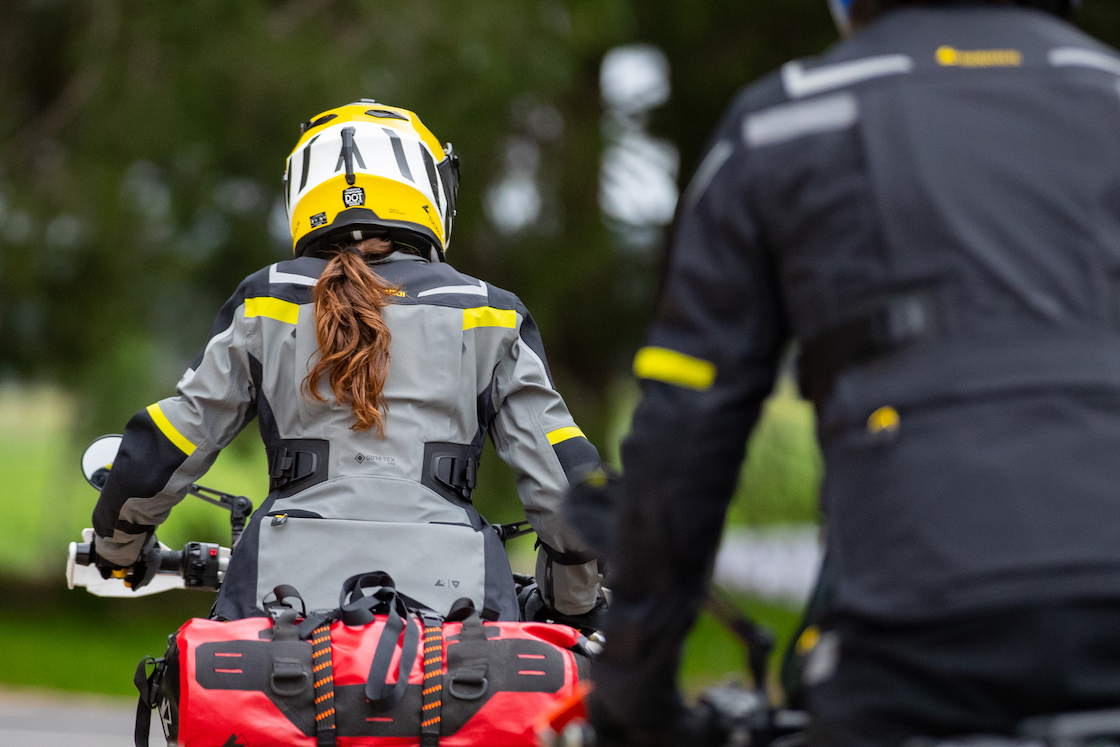
Prep Your Gear For Winter Riding
Now that your bike is prepped for some winter riding, it’s time to make sure you’re using the optimal ADV riding gear that will battle winter’s sometimes horrid conditions.
This list has been my go-to for two decades of riding throughout the winter months, which sometimes last five months in Northeastern Pennsylvania.
Take note: I don’t use heated vests, gloves, or any other electrically wired. I tested heated gear multiple times and never felt the need to use it because of my layering system and on-bike heated grips, and wind protection. However, others swear by heated gear—if you’re one of those, let us know what works best.
- Fog-Free Shield: If you can’t see, you’ll get hurt. It’s that simple. Also simple are the amazing products available for battling a foggy shield, including visors with Pinlocks or a non-foggy coating and spray-on chemicals. This was listed first for a reason; there’s no reason to ever ride with a foggy helmet in the age of modern motorcycling.
- Waterproof Gear: Waterproof gear is an absolute must for winter riding. A personal favorite for gloves, jackets, pants, and boots, along with a large percentage of adventure riders, including the staff at Touratech-USA, is gear built with GORE-TEX ProShell material. This fabric keeps you dry regardless of conditions while providing the protection needed. I once spent 13 hours in a mix of pouring rain and snow a few Decembers ago and remained completely dry. When it comes to experience, nothing beats GORE-TEX.
- Protective But Flexible: When conditions are cold and wet, crashes are more likely to happen. Make sure your gear not only does its work to protect but provides comfort while doing so. A favorite is Kevlar fabric combined with flexible interior armor, such as REV’IT SEEFLEX or D30. This type of protection remains flexible and comfortable until impact from a crash. Then it hardens and protects…almost magically, as I experienced once with D30 protection after nailing a branch at 80 mph on a fire road and walking away unbruised.
- Full-Length Boots: Don’t trust ankle boots or anything shorter for winter riding. The higher, the better. Find waterproof boots that lack ventilation (closed ventilation always passed cold air for me on various brands), and make sure to use moisture-wicking socks. Multiple companies make winter-focused riding socks; invest in them, and your feet will thank you (and your friends sharing tents or hotel rooms because some arrive with material like silver, so they don’t stink!).
- Base and Mid Layers: Unless I’m running to the wine store or testing/tuning a bike, I never ride without base layers— regardless of temperatures. Proper base layers are a must for riding in the winter. A favorite is Touratech’s Primero Alpine base layer, which I’ve used in temps well below 30 degrees for sustained riding with only a mid-layer up top and KLIM Badlands Pro ADV riding apparel. For anything below 45 degrees Fahrenheit or so, my typical outfit consists of Primero Alpine underlayers, a REV’It Mid layer zip-up, which is also a favorite off the bike, and the same Badlands jacket and pants. Once things get below 32, I simply add thermal over my base layer, and when temps go above 45, I remove the mid-layer, which packs down nicely and fits into a tank bag. Layering is key to comfort and the major reason I don’t use electrically heated gear.
- Neck Gaiter: Regardless of your bike’s, jacket’s, or helmet’s protection abilities, the cold always finds a way to creep into the neck and chin areas. Especially when it’s freezing, and you’re a long way from your destination. The simple solution is a neck gaiter. I use one for most riding situations below 70 degrees Fahrenheit. They also work great for hotter weather. I soak mine in water during extreme heat to further cool my neck. And when you’re riding in dusty situations, simply pull it over your mouth; the gaiter works wonders to keep the grit out.
- Helmet with Chin Curtains: On the topic of battling a cold neck and chin, chin curtains provide the optimal solution, from winter days to summer nights when the temps drop slightly. If your helmet doesn’t arrive with one, some aftermarket solutions exist—Google “motorcycle helmet chin curtain” for some quick results.
- Waterproof Gloves: Few things suck the joy from a winter ride faster than wet or cold hands. It’s worth the investment to get well insulated waterproof gloves. Gore-tex construction with a good gauntlet is ideal for keeping the weather out. A good winter glove should provide good grip on the bars while having insulation to keep the cold out. Even with heated grips, a good winter glove is needed to fully enjoy winter riding.
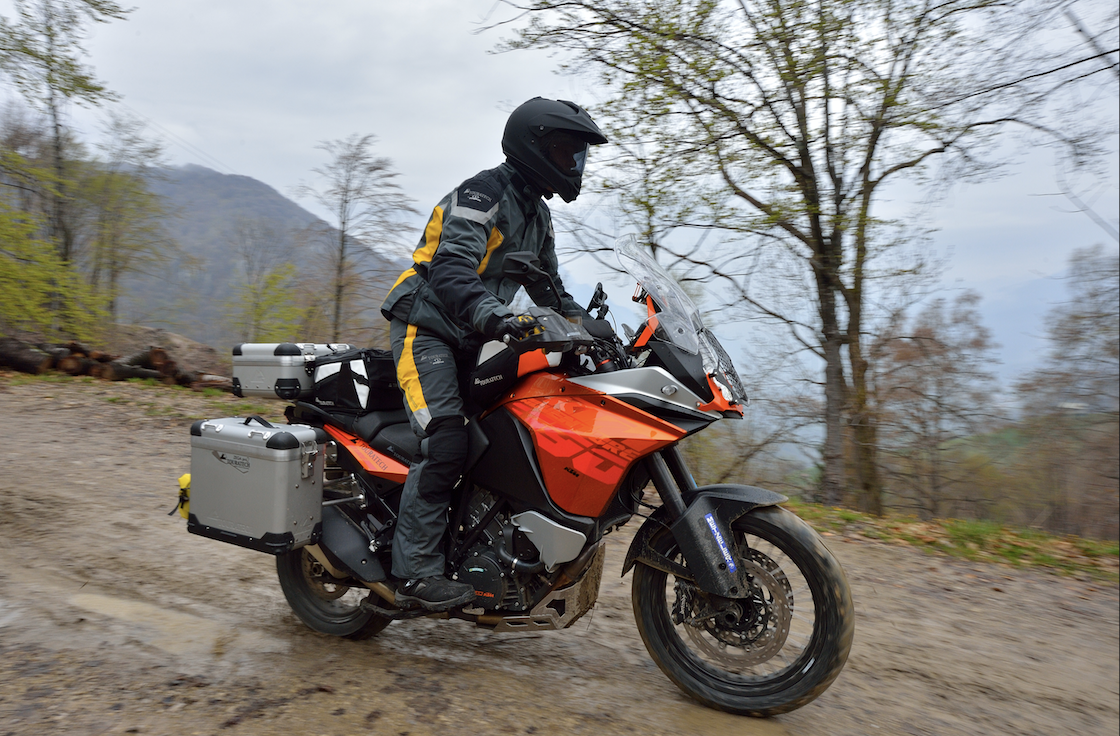
Winter Riding Techniques
Now that you got your bike and gear sorted for winter motorcycle riding, here are some riding tips. I learned the proverbial hard way by riding on cold tires and losing all feeling in my fingers (brakes don’t work that well), so these types can undoubtedly keep you safe and rider longer throughout the year.
- Finesse of Controls. I’ve learned how crucial it is to have finesse on a motorcycle’s controls during multiple road racing schools. You don’t grab at brakes or the throttle or make abrupt steering inputs. Those actions slow you down and lead to crashes (something most learn firsthand). The same is true for winter riding, especially considering your tires are much colder and won’t be as sticky. With that said, make sure to be extra gentle on the controls and inputs when you start riding—your tires are going to take longer to warm to temp. And when you stop on colder pavement—especially colder pavement that’s wet—your tires will lose heat quickly. Loss of heat means loss of traction. Remember, smooth is safer.
- Watch For Black Ice, Salt, and Fresh Cracks: Whatever it takes, avoid black ice. Nothing will send you grinding across the road or trail like black ice. Know the outside temperature, and remember that even if it’s warmer than 32 degrees, the road conditions can still be covered with black ice. Also, watch out for new cracks due to plows, evident on roads you ride frequently, and salt. Salt is like loose gravel, so treat it exactly the same.
- Don’t Just Check the Weather: Also, check the windchill. For example, if it’s 40 degrees Fahrenheit, and the wind is 39 mph, which the National Weather Service considers a “moderate” threat, the temperature will feel like 27 degrees Fahrenheit. Of course, you’re also riding at a set speed so that the actual temperature will feel even colder. For a cool tool, check out this Wind Chill Calculator.
- Increase Following Distance and Visibility: Riders who endure for decades of safe throttling understand that maintaining a larger following distance decreases the risk of crashing. According to the UK-based Begin Motorcycling, motorcycles take about 315 feet to stop while riding 70 mph. This is 24 car lengths. And this distance decreases when it’s colder due to less traction. The smart choice when riding in winter? Open up your following distance significantly. At speeds over 65 mph during colder weather, I usually keep an 8-second following distance ahead of me. Also, remember to increase your visibility by looking further down the road and knowing what’s constantly on your left and right’s field of vision.
- Look Left-Right-Left at Every Intersection: Automobile drivers barely notice motorcycles in the summer, and it gets worse in the colder months because drivers aren’t psychologically primed to see motorcyclists. As a result, most bike/car accidents occur at intersections. One thing I’ve learned to do, which has saved me multiple times, is to look left-right-left at every intersection. This practice has saved me numerous times, especially in the winter months.
- Stop More To Rejuvenate: The colder temperatures can cause two major issues: the possible loss of dexterity of your hands and feet, and tiredness both mentally and physically. If you’ve ridden unprepared for winter, you know exactly how this feels. The solution is simple—stop more to rejuvenate your body, including hydrating, resting, and warming up. When riding in temperatures lower than about 45, I force myself to stop at a minimum every two hours. If it’s snowing, it’s wiser to break even sooner.
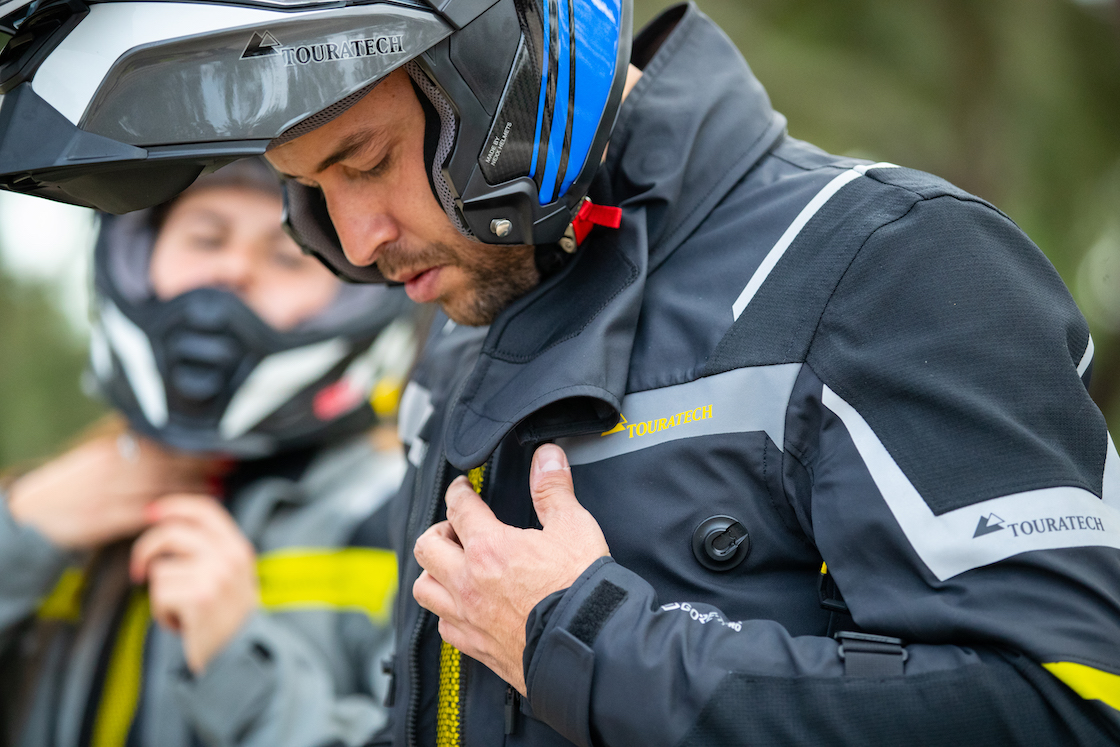
Even the most passionate riders who put on thousands of miles monthly are afraid of winter riding. There’s much fear naturally built into the concept. But once you practice the above preparation and riding tips, the fear will resolve.
And when that fear resolves, you’ll be able to enjoy more of the things you were partially put on this earth to do—enjoy the endless happiness of riding motorcycles, rain or shine, cold or snow.
